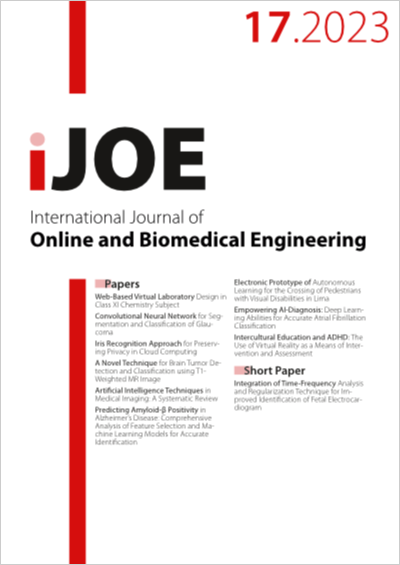Electronic Prototype of Autonomous Learning for the Crossing of Pedestrians with Visual Disabilities in Lima
DOI:
https://doi.org/10.3991/ijoe.v19i17.42875Keywords:
ESP32 master- ESP32 slave, visual impairment, HC-SR04 ultrasonic sensorAbstract
Difficulties related to vehicular chaos and obstacles in public spaces hinder the orientation of visually impaired individuals, limiting their autonomy and exposing them to potential accidents. Considering these factors, the objective was to develop a prototype that facilitates autonomous learning by utilizing different electronic components. The aim is to ensure the safe movement of blind pedestrians, promote self-reliance, and minimize the risk of accidents. The proposed prototype is based on the concept of implementing intelligent traffic lights that detect the presence of pedestrians, allowing for safe crossing for both pedestrians and vehicles. The proposed circuit utilizes two ESP32 modules. One module is placed in the traffic light and configured as a Bluetooth master to transmit signals. It is also equipped with an ultrasonic sensor. The other module is located in the user’s wristband and configured as a Bluetooth slave to receive signals. It is also equipped with a horn. The communication between the modules has been developed using the C programming language for microcontrollers in the Arduino IDE development environment. A master-slave communication system was implemented, resulting in the constant reporting of the distance between the pedestrian and the sidewalk within the pedestrian crossing by the ultrasonic sensor. This system controls the safe crossing by regulating the traffic lights. The HC-SR04 ultrasonic sensor can detect distances ranging from 2 cm to 450 cm. Therefore, the prototype can be used as a foundation for future advancements in various cities and contexts, ultimately benefiting blind pedestrians by improving their mobility.
Downloads
Published
How to Cite
Issue
Section
License
Copyright (c) 2023 Benjamin Luque-Milera, Alcides Alejandro Tocas-Taipe , Estefano Jose Luis Florian-Amaro, Brahyan Fabián Salinas-Carbajal, Axel Estrada-Ventocilla , Cristian Castro-Vargas, Jhony Miguel Sanchez-Ramirez, Maritza Cabana-Cáceres, Maritza Cabana-Cáceres, Cristian Castro-Vargas

This work is licensed under a Creative Commons Attribution 4.0 International License.


